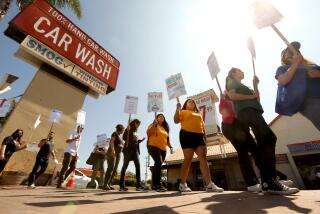Gov. Jerry Brown gets high marks for effectiveness in report card
- Share via
SACRAMENTO — The year shouldn’t slip by without giving Gov. Jerry Brown his annual report card.
And that’s tough. Not the grading: He obviously deserves high marks if the yardstick is effectiveness. And that’s my yardstick.
The only decision is whether to give him a B-plus, an A-minus or a full A.
The tough part is acknowledging that Brown, who regards himself as the smartest man in the room and tends to let people know it, usually is. Certainly he was in 2012.
This was the year Brown delivered what he was selling when he ran for election in 2010: political know-how, inherited from his father Pat Brown’s genes and developed over decades of trial and error; the governor uniquely qualified by experience and wisdom to clean up Sacramento’s fiscal mess.
“The knowledge and the know-how to get California working again,” he had proclaimed. “That’s what I offer.”
Largely because of Brown, Sacramento is approaching solvency after several years of deficit chaos and sharp spending cuts.
The numbers change every week. But essentially Brown entered office facing a $26-billion deficit. It was halved to $13 billion by the end of 2011 and recently was projected by the nonpartisan legislative analyst to be a relatively minor $1.9 billion for the next budget year.
Brown and the Democratic-controlled Legislature cut a ton, mainly in programs for poor people. University students also got whacked
But Brown’s biggest test was winning voter approval of a tax increase, the first accepted by the California electorate since 2004.
Again, the governor fulfilled a campaign promise: “No new taxes unless the people vote for them.”
That was an unfortunate, politically motivated pledge aimed at convincing voters that he wasn’t a liberal taxer-spender. It surrendered his and the Legislature’s constitutional power to raise taxes on their own.
Nevertheless, Brown did it his way, the risky way. And it turned out to be the winning way. It wasn’t even close: a margin of 10.6%.
If Brown had flunked that exam, we’d be handing out a D, maybe an F. K-12 schools would have been slashed $5.4 billion.
“He showed people once again that he knows how to run a statewide campaign,” says Mark Baldassare, president and pollster of the Public Policy Institute of California.
Brown did it, in part, by compromising with the left on his ballot initiative. He merged his tax proposal with a more liberal version sponsored by the California Federation of Teachers. The combined measure became Proposition 30, which raised income taxes substantially on the top 1% and imposed only a token quarter-cent sales tax hike on everyone.
It was bad public policy, rendering California’s tax system even more unstable by over-relying on the roller-coaster fortunes of the wealthy. But it was superb politics: soaking the rich. Only a relative handful of voters would be paying the higher tax.
Brown defied conventional wisdom by campaigning on college campuses. Political pros rolled their eyes. Young people don’t vote, they observed.
But this year they apparently did, aided for the first time by online voter registration. They also were sick of tuition hikes. And if Prop. 30 did not pass, they were guaranteed even higher fees. Plus, President Obama was still a draw for California youth.
“Give Brown credit,” says Dan Schnur, director of the Jesse M. Unruh Institute of Politics at USC. “A septuagenarian governor doesn’t seem like a logical messenger for college undergrads, but he made it work.”
“Not only did he win student votes,” Schnur adds, “but all those campus visits had a reflective value by reminding older voters that they were young once and why college educations are so important.”
Brown also got lucky.
First, Obama was running and that attracted more voters than would have shown up if the governor had succeeded in his first choice: persuading GOP lawmakers to place a tax measure on a special election ballot in 2011.
Second, anti-labor conservatives sponsored an initiative, Proposition 32, aimed at crippling unions. Prop. 32 frightened unions into self-survival action. And they turned out voters who helped pass Prop. 30.
Brown also racked up other achievements in 2012.
A controversial bill to overhaul workers’ compensation was all but dead before Brown stepped in, as Times business writer Marc Lifsher reported. The governor personally lobbied reluctant senators and ultimately won over unusually large, bipartisan majorities.
The agreement is expected to provide $740 million annually in new benefits for permanently disabled workers, while reducing overall medical and compensation costs and saving businesses huge hikes in workers’ comp insurance.
Business interests are generally happy with this Democratic governor.
Brown also pushed passage of a modest public pension reform, knowing it was needed to persuade voters that Sacramento was doing everything it could to reduce taxpayers’ burden.
The compromise satisfied hardly anyone — unions or union critics — but it was more pension reform than had ever been passed by the Legislature.
For new employees, it was designed to eliminate $100,000-plus pensions, raise retirement ages and reduce other benefits. Both current and future employees will have to pay roughly half their retirement costs.
And — like it or not, and most people apparently don’t — Brown got the bullet train moving after it had been sidetracked for years. He persuaded the Legislature to spend the initial $8 billion in high-speed rail construction money ($4.7 billion in voter-approved state bonds, $3.3 billion in federal grants).
Of course, that leaves only $5 billion remaining for a $68-billion project. And no one is offering to pay for the rest of this fantasy.
But, again, the grading here is based on effectiveness.
And Brown earned a solid A.
More to Read
Sign up for Essential California
The most important California stories and recommendations in your inbox every morning.
You may occasionally receive promotional content from the Los Angeles Times.











